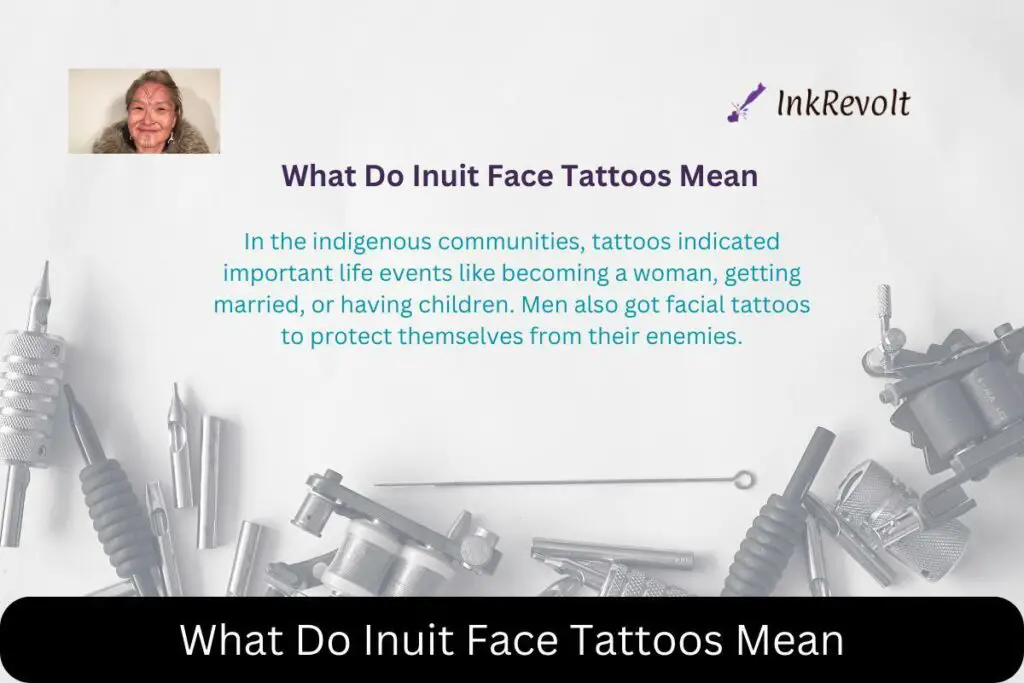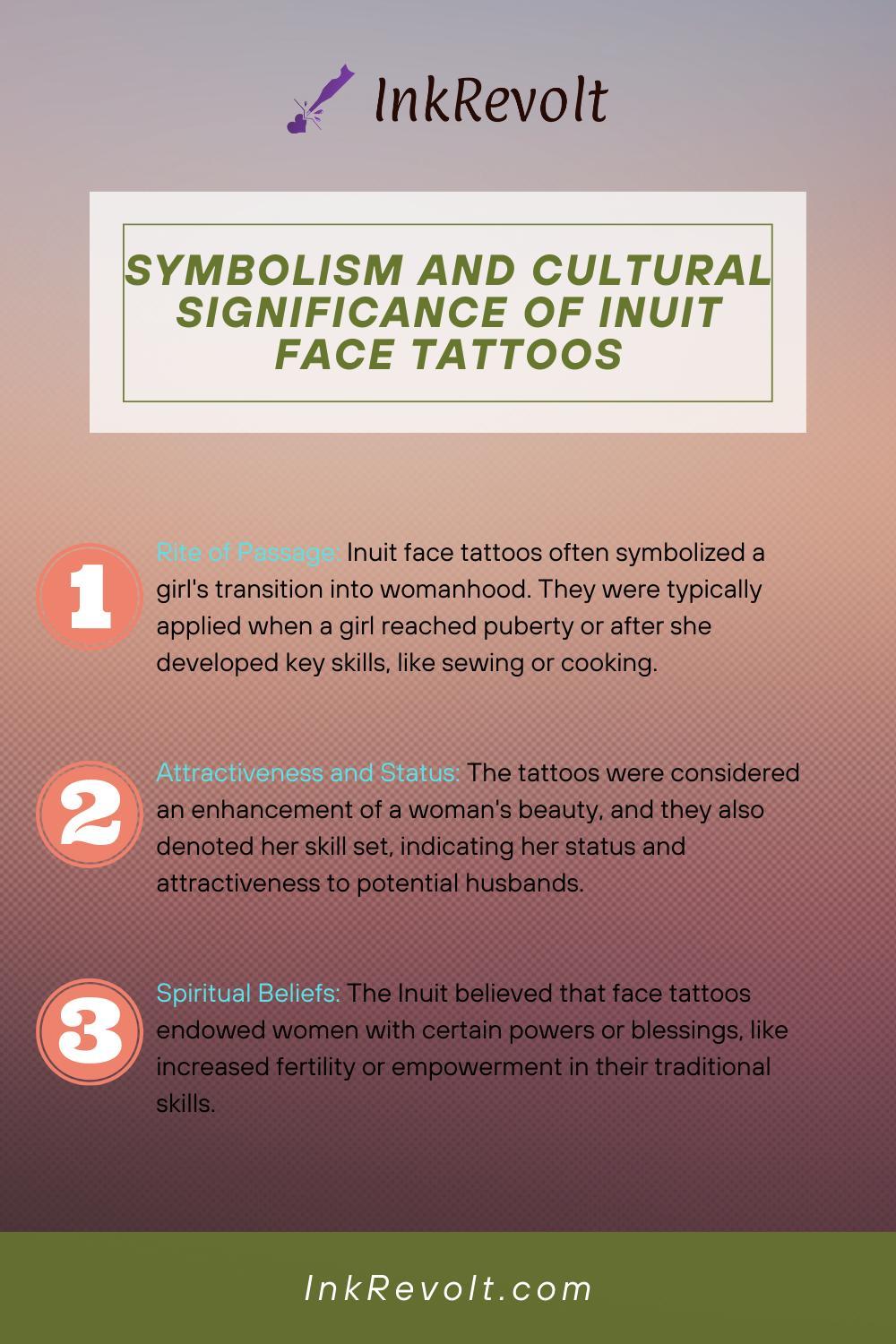What Do Inuit Face Tattoos Mean?
In ancient times, some people used to have tattoos to protest or rebel against something. Then the trend has transformed dramatically over time, becoming more common among everyone. However, tattooing has a different appeal to Inuit women. It is more like a tradition for them, passed on from one generation to another with tattoos of various meanings.
In the indigenous communities, tattoos indicated important life events like becoming a woman, getting married, or having children. Men also got facial tattoos to protect themselves from their enemies.
Facial tattoos were an integral part of the lifestyle of Inuit people. So, the tattoos, along with their history, have different designs, symbols, and cultural significance. The article will illustrate all of them.

The History Of Inuit Face Tattoos
Inuit people have had a thing for tattoos for hundreds of years. It was so long ago that no one is sure how far the Inuit tattooing tradition goes back. Referring to the book by Lars Krutak, Tattoo Traditions of Native North America: Ancient and Contemporary Expressions of Identity, you have to look back at a minimum of 3,600 years of prehistoric evidence.
An ivory mask was identified in 1986 on Devon Island, Nunavut. It featured a tattooed family body decorated with many facial tattoos. Then a tattoo anthropologist, Krutak, studied it. Upon his knowledge of tattoos from recent history and prehistoric times, he found that the ivory mask tattoo was completely the same.
Inuit, along with other indigenous tribes, were eradicated from Canada and Alaska and were given shelter in boarding institutions. The removal uprooted them from their homes, families, and communities.
But that was not all. The missionaries and schools forced them to adopt Christian beliefs to Westernize their lifestyle and culture. They were barred from donning their traditional apparel, talking in their languages, and practicing tribal costumes like getting tattoos. The Inuit art of tattooing was almost dying at the beginning of the 20th century.
It might have been that way, and the tattoos would have been tales of the Inuit had it not been for the Inuit Tattoo Revitalization Project and the documentary Tunnit: Retracting the Lines of Inuit Tattoos. Both initiatives spurred the almost-lost tradition to make a fierce comeback.
The project photographer, Cora DeVos, made a statement, hinting at the progressive trend of the Inuit culture, “When the project first started, I think there were maybe three Inuit women that were wearing the traditional markings. Now there are hundreds of women all over Canada that are wearing them. It’s beautiful to watch it come back to our culture.”
Think of a tattoo culture with a rich history reviving in an era where people are crazier about tattoos than ever. So, of course, the Inuit people are having a blast at the moment. Here is more about their tattoo symbols and meanings.
The Designs Of Inuit Face Tattoos
Traditional tattooing practice and style vary greatly from one tribal group to another in the North. It can also depend on specific regions. Regardless, you will find some common themes everywhere.
There are designs of geometric triangular shapes, lines, straight lines, dots, circles, etc. Each represents a significant occasion, a beginning, or an introduction to something. You will also notice common facial markings tattooed on the forehead, chin, or around the eye corner. The most widely seen facial tattoo is a three-line one, beginning from the lip and going below the chin.
The Symbolism And Cultural Significance Of Inuit Face Tattoos
Each facial tattoo carries a symbolic meaning, serving various purposes, including the celebration and commemoration of the life and its vital incidents.
For example, they can stand for specific phases of life, such as womanhood, motherhood, and marriage. A V-shaped design on the forehead means that the bearer has marked the age of maturity. It used to be the first tattoo for numerous Inuit women, a sign of their first period.

But it was not the same everywhere. The lands of the Inuit people were diverse and vast. In some parts, the first tattoo for an Inuit was often a chin tattoo. Women got it for the same reason above, and men also had it to protect themselves during raids against their rivals.
Every tattoo is closely related to the people’s tribal and cultural identity. You could recognize their clans and families just by glancing at their tattoos. A facial tattoo of a woman was enough to tell you about her region, achievements, and position in her community.
Traditional Techniques And Tools
The traditional techniques of tattooing included bone-made needles. Women soaked sinew in suet, applying materials like a thread from caribou sinew. They used soot and oil to soak it in, got it into a needle, and sewed in one’s skin to create a tattoo design.
Now, things have changed, and there are modern devices and ink for tattoos. Yet many choose the traditional techniques of hand-stitching or hand-poking tattoos, albeit in a much more hygienic manner.
For example, Nordlum, a traditional Inuit tattoo artist, uses hand-stitching and hand-poking tools without any device. It is a procedure that requires needles to get the ink into your skin through a pin device. The artist particularly uses it for Inuit tattoos only.
On the other hand, the skin stitching process includes a needle with a thread dipped in the tattoo ink. It leaves a permanent layout by pushing the ink under your skin with the needle.
Final Words
Facial tattoos signify the history and tradition of the Inuit people. They unify them by solidifying their commitment, connection, and belongingness to the community. They also stand for the personal accomplishments of Inuit women.
Each tattoo marking has an innate story and celebration that makes them proud of who they are and where they are from. The way their tradition has come back after dying out due to colonization, it is only a matter of time before the tattoo world sees the Inuit people reigning over with their signature tattoos.
